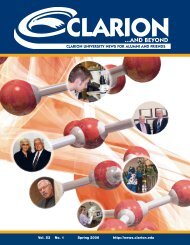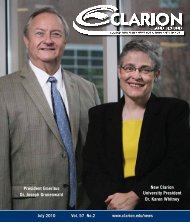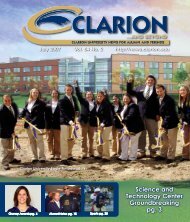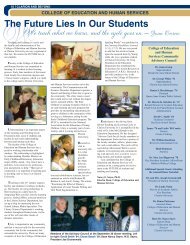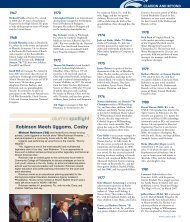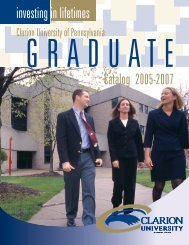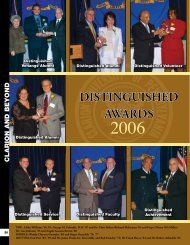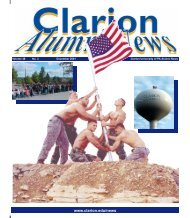<strong>Clarion</strong> <strong>University</strong> of Pennsylvania 23A maximum of six credits from the 400-level courses listed below can be taken for graduate credit with permission from the graduateprogram coordinator or department chair. 400-level courses taken for undergraduate credit cannot be repeated for graduate credit.Biology Courses410: Field Methods in Environmental Biology 3 s.h.A field-based course designed to give students hands-on experience in the various methods needed in environmental studies.The course will focus on the environmental assessment of terrestrial and aquatic habitats and the impacts of perturbationson flora, fauna, and natural landscapes. Prerequisites: BIOL 155/156: Principles of Biology II and laboratory, BIOL 202:Principles of Ecology, or permission of instructor. Summers, on demand.BIOL 460: Comparative Vertebrate Anatomy 3 s.h.Traces the most important trends in the evolution of basic structures in vertebrate lines and conveys an appreciation of howthe mammals came to possess the combination of characters that make this group unique. Two lecture and three laboratory hoursweekly. Prerequisites: Completion of two semesters of introductory biology or permission of instructor. Alternate years.BIOL 464: Developmental Biology 3 s.h.Study of the major processes in development and their underlying mechanisms. Includes descriptive study and mechanismssuch as differentiation, induction, and morphogenesis. Deals primarily with animal development. Two lecture and threelaboratory hours weekly. Prerequisites: Completion of two semesters of introductory biology, genetics, and two semesters ofgeneral chemistry or permission of instructor. Annually.BIOL 470: Mammalology 3 s.h.Interrelationships of mammals and the biotic and abiotic environment. Includes discussions and investigations of mammaliandistribution, diversity, taxonomy, ecology, and physiology. Includes both field and laboratory studies. Two lecture and threelaboratory hours weekly. Prerequisite: A course in ecology or permission of instructor. On demand.BIOL 471: Plant Ecology 3 s.h.In-depth approach to the interaction of plants with the physical and biotic environments at population, community, ecosystem,and landscape scales. Lecture and discussion focus on current topics in plant ecology such as disturbance, succession, herbivory,dispersal, competition, and environmental stress. Laboratory includes field-based experimental and descriptive investigationsof plant population and communities. Two hours lecture/discussion and three laboratory hours weekly. Prerequisite: A coursein principles of ecology or permission of instructor. On demand. (Pymatuning)BIOL 500: <strong>Graduate</strong> Seminar 1-2 s.h.A survey of current literature, concepts, and theories from selected fields of biology. Two discussion hours weekly. Byarrangement.BIOL 502: Biometry 3 s.h.Collection, analysis, and presentation of biological data. Fundamental aspects of designing and executing descriptive andexperimental studies with emphasis on biological research. Applications to undergraduate and graduate research in progressin the Department of Biology are stressed. Three lecture hours per week. Spring, alternate years.BIOL 503: Special Topics in Biology 1-4 s.h.Semi-independent studies of topical material under the guidance of the instructor. Maximum credit allowable towardgraduation: nine semester hours. Prerequisites: permission of instructor and the student’s graduate committee.BIOL 504: Computational Molecular Biology and Bioinformatics 3 s.h.The new disciplines of genomics, proteomics, and bioinformatics attempt to analyze and make sense of the data generatedby the Human Genome Project and other genome projects. This course is an introduction to the computational techniques andalgorithms which are used. Topics will include data base searches, pair-wise and multiple alignments, similarity searching,protein structure, gene mapping and genomic maps and simulation. This interdisciplinary course will be of interest to studentsin biology, molecular biology, ecology, evolutionary biology, biochemistry, industrial mathematics, and computational science.Prerequisite: BIOL 201 Genetics and MATH 260 Applied Calculus or MATH 221 Elementary Applied Statistics, or permission ofinstructor. No programming experience is necessary, but a facility with computers is assumed. Pre-session, alternate years.BIOL 505: Ecological Applications 3 s.h.A case history approach to the analysis and possible resolution of both terrestrial and aquatic environmental problems.Students will analyze the problem from a number of perspectives, including the biological, in an assessment of the problem.Sample design, cost considerations, data collection, and analysis will be incorporated into the assessment. The overall assessmentof the problem and possible resolution will be conveyed both orally and in a written format. This course is considered a capstonefor students in the Applied Ecology Program, but is appropriate for other students who meet the prerequisites. Prerequisites:BIOL 202, or permission of the instructor. BIOL 493 and 494 are recommended. Spring, alternate years.BIOL 508: Biology Internship 1-3 s.h.Internships provide practical experiences that are related to a student’s academic program or research area. Credits earnedcan be utilized as partial fulfillment of the Master of Science degree in biology. Students considering internship credits to beapplied toward the Master of Science degree must have the approval of their graduate advisory committee, the cooperatingagency, and the appropriate university administrators. On demand.BIOL 511: Wildlife Ecology and Management 3 s.h.A study of the ecology and management of mammals, birds, amphibians, and reptiles. Lectures cover population dynamics,estimation, and population viability, sampling techniques, habitats, disease, and both game and non-game management. Labsemphasize wildlife population modeling, habitat assessment using GIS, and evaluation of alternative management strategies.Students will develop their own wildlife management plans. Two hours of lecture and three hours of laboratory weekly.Prerequisite: BIOL 202 or permission of instructor. Fall, alternate years.Biology
24 <strong>Clarion</strong> <strong>University</strong> of PennsylvaniaBiologyBIOL 520: Terrestrial Botany 3 s.h.A field course emphasizing the identification, distribution, and ecology of upland vascular plants of Western Pennsylvania.Field and laboratory projects will focus on plant characteristics, taxonomic relations, floristics, habitat relationship, inventorymethods, and plant community description and dynamics. (Pymatuning)BIOL 521: Aquatic Entomology 3 s.h.Emphasis in this course is on identification of the major groups of invertebrates playing a role in natural communities andon the methods of quantifying their relative importance in the community. (Pymatuning)BIOL 522: Aquatic Botany 3 s.h.Study of freshwater algae and aquatic vascular plants in field communities, methods of quantifying relative numbers andmass, and structural and physiological adaptations to the aquatic environment. (Pymatuning)BIOL 523: Experimental Vertebrate Ecology 3 s.h.Designed to give knowledge of basic field identification, capture techniques, quantification, and natural history of someof the common vertebrates of Pennsylvania. (Pymatuning)BIOL 524: Microbial Physiology 4 s.h.A study of the physiological reaction involved in the growth, reproduction, and death of microbes. Consideration isplaced upon the metabolism of carbohydrates, proteins, vitamins, and fats. Enzymes, oxidation-reduction potentials, energyrelationships, membrane potentials, and nutrients are considered. Prerequisites: General Microbiology and Biochemistry orpermission of instructor. Two lecture and four lab hours per week.BIOL 525: Fisheries Biology 3 s.h.Ecology of fish populations, including identification, age and growth, populations estimation and analysis, food habits,environmental requirements, and management considerations. Prerequisites: Environmental Biology or permission ofinstructor. Three lecture hours per week. Laboratory sessions held on Saturdays. Student must possess a valid Pennsylvaniafishing license.BIOL 526: Field Ichthyology 3 s.h.A field course dealing with the interrelationships of fish with their biotic and abiotic environment. Fish in their naturalhabitats, pollution, and improvements of aquatic habitats, and applied aspects of fish ecology and fishery management will bestudied. (Pymatuning). Student must possess a valid Pennsylvania fishing license.BIOL 527: Field Botany 3 s.h.Field-based course emphasizing the identification and natural history of common vascular plants native to westernPennsylvania and methods used to study them. Course is taught at a time when the spring flora is conspicuous. Spring,alternate years.BIOL 528: Ornithology 3 s.h.This course deals with the biology of birds. Lectures cover topics such as classification, internal and external adaptationsfor flight, migration, nesting and feeding habits, behavior, ecology, and physiology. There are two lectures and three laboratoryor field trip hours per week. Prerequisite: Permission of the instructor. Spring, even-numbered years.BIOL 532: Field Ornithology 3 s.h.This course deals primarily with the identification and natural history of birds of western Pennsylvania. It is taught at atime when migratory species are also commonly seen. Although lectures are an important component, indoor and outdoorlaboratory activities play a predominant role in this course. Prerequisites: BIOL 155/165; BIOL 156/166; or permission ofthe instructor. Spring, even-numbered years.BIOL 543: Virology 3 s.h.A study of plant, animal, and bacterial viruses, including the biochemistry of viruses and viral life cycles, techniques inthe study of viruses in relation to diseases, tumors, and cancer. Prerequisites: Microbiology or Biochemistry or permission ofinstructor. Three lecture hours per week.BIOL 544: Immunology 4 s.h.A study of cellular immunology, immunochemistry, and immunogenetics, with emphasis on the physiology of immuneresponses. Prerequisite: Permission of instructor. Three lecture and three lab hours per week.BIOL 546: Pathogenic Microbiology 4 s.h.A study of the bacteria, fungi, and viruses which cause human disease. Laboratory emphasis is on isolation and identificationof pathogens and on elementary immunology. Two lectures and four laboratory hours weekly. Prerequisites: BIOL 341.Spring, annually.BIOL 550: Cell Physiology 4 s.h.Explores the molecular dynamics of eukaryotic cells. Includes functional and structural organization of the cell, the cellas a unit of inheritance, and the cell as a biochemical transducer. Prerequisites: C or better in BIOL 155, 156, 165, 166, and203, and completion of CHEM 252 and 262 or permission of instructor. Fall semester only.BIOL 551: Advanced Animal Physiology 1-3 s.h.A detailed treatment of fundamental concepts and techniques of animal physiology. Includes literature reviews andindividual investigations. Two lecture and three lab hours per week.BIOL 552: Advanced Plant Physiology 3 s.h.Life processes and responses of plants to the environment. Topics include water relations, transpiration, translocation,photosynthesis, respiration, metabolism, plant hormones and morphogenesis, photoperiodism, temperature responses,environmental and stress physiology. Two lecture and three lab hours weekly. Prerequisites: BIOL 201, 203, and CHEM 254.Spring, odd-numbered years.



